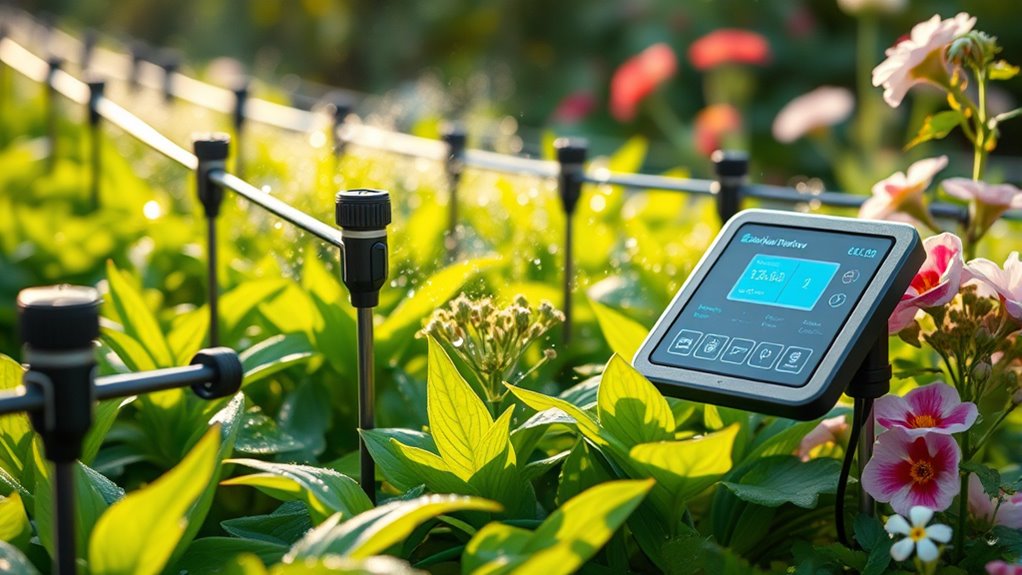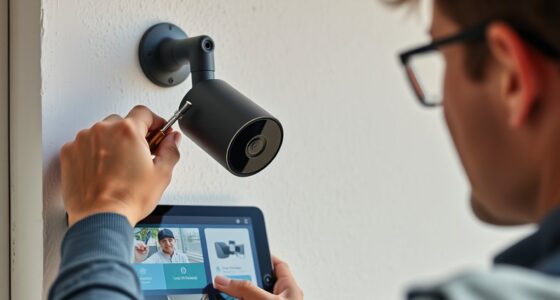A smart irrigation system uses sensors, weather data, and automation to deliver water precisely when and where your garden needs it. It monitors soil moisture, adjusts schedules based on weather forecasts, and can be controlled remotely from your device. This setup saves water, reduces utility bills, and promotes healthier plants. Curious about choosing, installing, or maintaining one? Keep exploring to discover how these innovative systems can transform your garden care.
Key Takeaways
- Smart irrigation systems use sensors and data analytics to deliver precise watering, reducing water waste and promoting healthy plant growth.
- Integration with weather data allows automatic schedule adjustments based on rain forecasts and environmental conditions.
- Automated controls and remote access enable convenient management of garden watering from anywhere.
- Different system types, including drip, sprinkler, or hybrid setups, support efficient and customizable irrigation solutions.
- Future innovations include AI-driven systems and drone integration for enhanced landscape monitoring and sustainable watering practices.
Understanding Smart Irrigation Technology
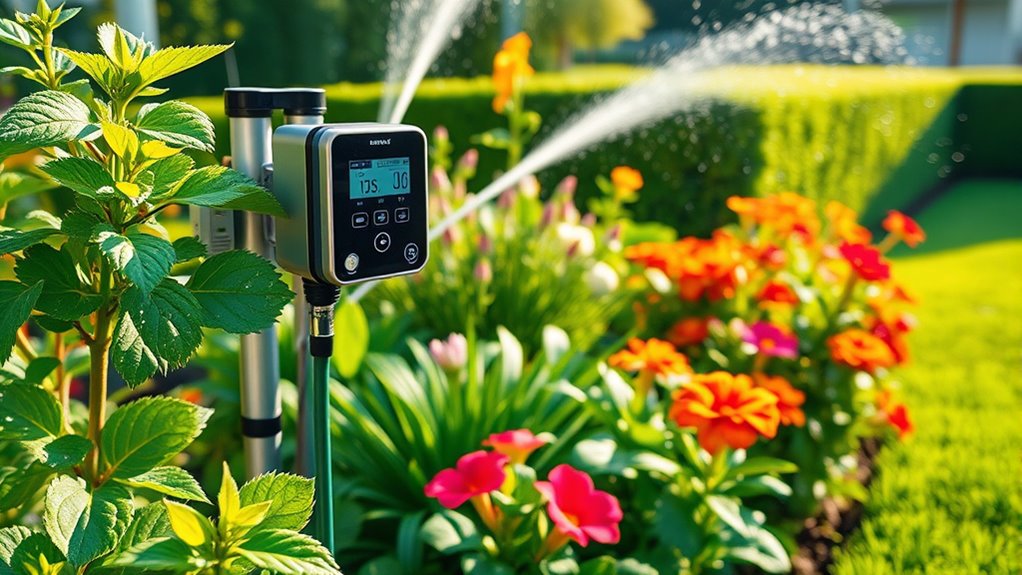
Smart irrigation technology combines sensors, data analytics, and automated controls to optimize watering schedules. You can monitor soil moisture levels in real-time, ensuring your garden receives the right amount of water without waste. Sensors placed in different irrigation zones provide precise data, helping you tailor watering to each area’s specific needs. Automated controllers adjust watering times and durations based on this information, preventing overwatering or underwatering. By dividing your garden into irrigation zones, the system manages water distribution efficiently, reducing runoff and conserving resources. This technology makes it easier for you to maintain healthy plants while minimizing water use. Additionally, high-precision projectors can enhance the visualization of your garden plans and system layouts, making setup more intuitive and accurate. Understanding these components helps you appreciate how smart irrigation systems deliver targeted, efficient watering tailored to your garden’s unique requirements, ultimately promoting water conservation and sustainable gardening practices. Furthermore, the integration of AI-driven data analysis enables the system to learn and adapt over time, improving efficiency and water savings. Incorporating soil health insights can also help optimize watering schedules for healthier plant growth.
Benefits of Installing a Smart Irrigation System
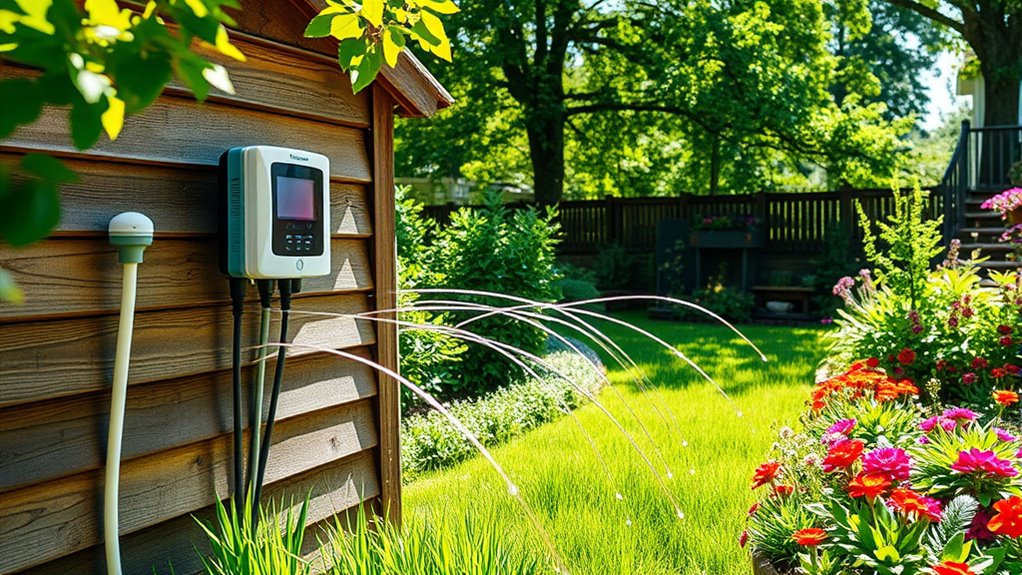
Installing a smart irrigation system offers numerous advantages that can substantially improve your gardening experience. It helps conserve water, reduces your utility bills, and promotes healthier plants by delivering precise watering. With features like sprinkler automation, your system adjusts watering schedules based on weather conditions, ensuring your garden gets the right amount of water. If you use drip systems, you’ll benefit from targeted watering that minimizes waste and prevents overwatering. Plus, smart systems often include remote control capabilities, giving you convenience and control from anywhere. Additionally, understanding the importance of proper bicycle maintenance can help you protect your investment and ensure your equipment functions optimally, much like maintaining an irrigation system for longevity. Regular system checks and updates ensure your watering schedule remains efficient, preventing issues like overwatering or system failures. Incorporating weather sensors can further optimize water usage by providing real-time data, aligning with the goal of water conservation. Moreover, integrating smart home technology can enhance overall system management and efficiency.
Types of Smart Irrigation Systems Available
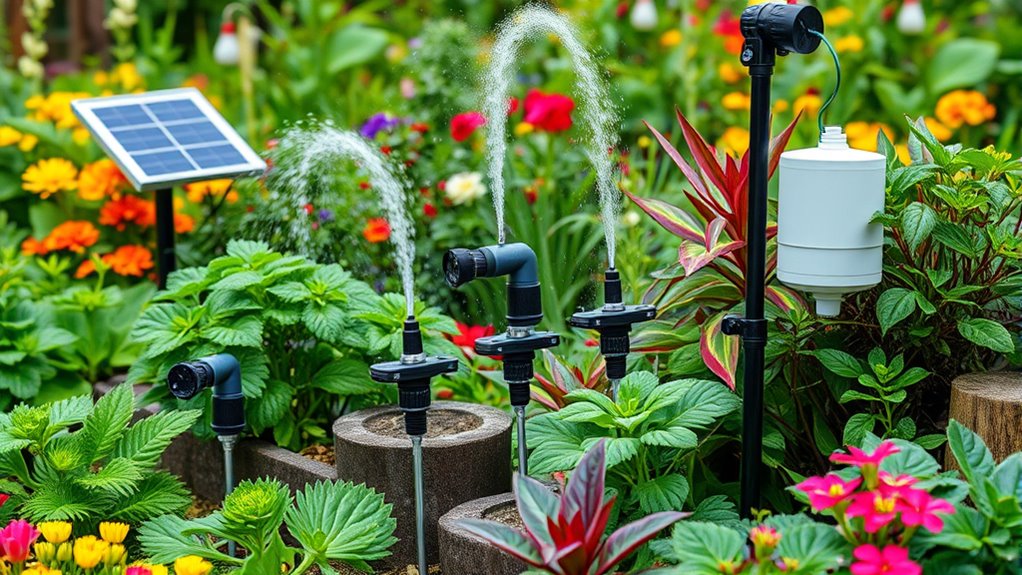
There are several types of smart irrigation systems you can choose from, each designed to meet different gardening needs and settings. Drip irrigation systems deliver water directly to plant roots, reducing waste and ensuring efficient watering, perfect for vegetable gardens and flower beds. Sprinkler systems, on the other hand, cover larger areas and can be programmed to water lawns or expansive landscapes. Modern smart sprinklers use sensors and weather data to adjust watering schedules automatically, saving water and preventing overwatering. Some systems combine both methods, allowing you to customize watering zones based on plant types and terrain. Whichever type you select, these smart systems help you maintain a healthy garden while conserving water and reducing manual effort.
How to Choose the Right System for Your Garden

Choosing the right irrigation system depends on your garden’s size, plant types, and specific watering needs. To prevent issues like plant disease, maintaining proper soil moisture is essential. Consider these factors:
- Garden size: Smaller gardens may benefit from drip systems, while larger areas might require sprinklers. Matching the system to your garden’s scale ensures efficient watering and resource use. Additionally, understanding watering system types can help you select the most suitable option for your landscape.
- Plant types: Sensitive plants need gentle watering to avoid overwatering or damage.
- Soil moisture control: Systems with soil moisture sensors help prevent overwatering, reducing plant disease risk. Additionally, selecting a system with watering schedule automation can ensure consistent watering tailored to your garden’s requirements.
Setting Up and Installing a Smart Irrigation System

Setting up your smart irrigation system is straightforward if you follow the right steps. You’ll need to select the appropriate system, install it carefully, and connect the smart sensors for peak performance. Let’s walk through each step to ensure your setup is efficient and effective. To maximize your system’s efficiency, consider proper installation and ensuring your system is well-maintained over time. Incorporating home decor elements into your garden setup can also enhance its visual appeal and harmony with your outdoor space.
Choosing the Right System
Selecting the right smart irrigation system depends on your garden’s size, type of plants, and local climate. Consider how soil moisture levels influence watering needs and plant health. A system that adapts to weather conditions can save water and prevent overwatering. To choose wisely, think about:
- The scale of your garden and whether a drip or sprinkler system suits it
- Compatibility with soil moisture sensors for real-time adjustments
- Features that monitor plant health and adjust watering accordingly
Also, assess if the system offers customizable schedules and remote control. The right choice ensures consistent soil moisture, promoting healthy plants while conserving water. Tailoring your system helps your garden thrive without wasting resources, making smart irrigation a practical investment.
Installation Step-by-Step Guide
Installing your smart irrigation system begins with careful planning and preparation. Start by mapping your garden, noting plant types and garden aesthetics to guarantee even coverage. Choose suitable locations for the controller and valves, considering accessibility. Use the table below to organize your setup:
| Step | Action | Tips |
|---|---|---|
| 1. Plan layout | Draw your garden and zones | Maximize coverage and efficiency |
| 2. Install main line | Lay tubing from water source | Secure connections to prevent leaks |
| 3. Connect valves | Attach valves to zones | Ensure proper sealing |
| 4. Mount controller | Place in accessible, shaded area | Protect from weather |
| 5. Test system | Run through zones to check flow | Adjust for excellent plant health |
Proper installation boosts garden aesthetics and promotes healthy plants by delivering water precisely where needed.
Connecting Smart Sensors
To guarantee your smart irrigation system functions efficiently, connecting smart sensors is an essential step. These sensors monitor soil moisture levels and plant health, ensuring your garden receives just the right amount of water. Proper installation helps prevent overwatering and underwatering, promoting healthier plants. When setting up your sensors, consider their placement:
- Insert soil moisture sensors at root level in different garden zones
- Connect sensors to your irrigation controller or hub
- Calibrate sensors according to soil type and plant needs
- Ensure your sensors are compatible with your wireless connection for seamless communication
Additionally, selecting sensors with features like durability in outdoor environments can enhance longevity and performance. This setup allows your system to respond dynamically to real-time data. Incorporating sensor calibration ensures readings are accurate and tailored to your garden’s specific conditions. By focusing on soil moisture and plant health, you optimize water use and keep your garden thriving. Proper sensor placement is crucial for accurate readings and effective watering. Accurate sensor connections are key to a smart, efficient irrigation system.
Integrating Weather Data for Optimal Watering
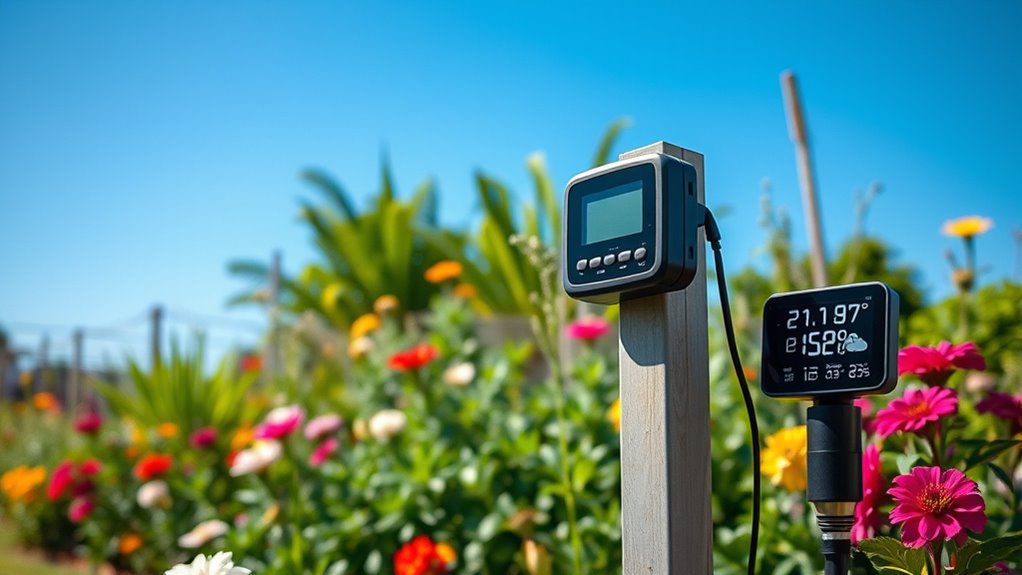
By integrating weather data, you can make smarter watering decisions that save water and promote healthy plants. Real-time updates let your system respond quickly to changing conditions, while rain forecasts help prevent unnecessary watering. Adjusting schedules based on weather guarantees your garden gets just the right amount of water every time. Incorporating sound recording techniques can further optimize system performance and reliability. Additionally, understanding weather patterns can enhance the accuracy of your water management strategies. Leveraging time zone information ensures precise scheduling for gardens in different locations, especially when managing multiple sites or remote systems. Being aware of juice cleansing impacts can also inform sustainable water use practices in garden maintenance. Furthermore, analyzing AI discoveries related to environmental data can lead to more innovative and adaptive irrigation solutions.
Real-Time Weather Updates
Real-time weather updates play a vital role in maximizing irrigation schedules, ensuring plants receive the right amount of water when they need it most. By continuously monitoring weather conditions, you can prevent overwatering or underwatering, promoting healthier soil moisture levels and improving plant health. Accurate weather data helps your system adjust watering based on current rainfall, humidity, and temperature, making watering more efficient. Incorporating natural and organic factors into your irrigation planning can further enhance water conservation and plant vitality. Integrating real-time weather updates ensures your garden receives precise watering, supporting optimal plant growth while conserving water resources. This proactive approach keeps your plants healthy and thriving, regardless of changing weather conditions.
Adjusting Watering Schedules
Integrating weather data into your irrigation schedule allows your system to respond dynamically to changing conditions, guaranteeing plants get the right amount of water. By monitoring soil moisture levels alongside weather forecasts, you can adjust watering frequency to prevent over- or under-watering. For instance, if rain is forecasted, your system can reduce or skip scheduled watering, saving water and promoting healthy roots. Conversely, during dry spells, it can increase watering to maintain ideal soil moisture. This real-time adjustment helps your garden stay resilient and reduces water waste. Fine-tuning your watering schedule based on weather data ensures your plants receive consistent, appropriate hydration, supporting their growth and health while making your irrigation system more efficient and environmentally friendly.
Rain Forecast Integration
Rain forecast integration allows your irrigation system to automatically adapt to upcoming weather conditions, ensuring you don’t waste water when natural rainfall is expected. By syncing weather data with your system, you can optimize water use and protect soil moisture levels. This prevents overwatering and keeps your garden healthy during rainy days. With weather-aware control, your drip irrigation system can skip scheduled watering if rain is forecasted, saving water and energy. It also helps you adjust watering times based on forecast accuracy, ensuring soil moisture stays consistent.
- Reduce unnecessary watering during rain events
- Maintain ideal soil moisture levels effortlessly
- Extend the lifespan of your drip irrigation components
Integrating weather data makes watering smarter, more efficient, and eco-friendly.
Monitoring and Managing Your System Remotely
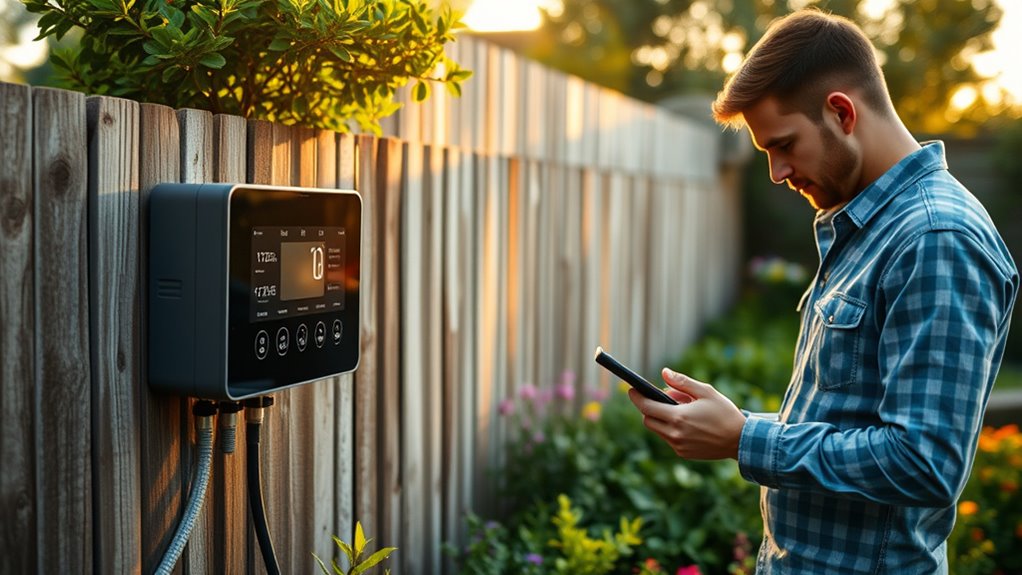
Thanks to advances in technology, you can now monitor and manage your smart irrigation system from anywhere using your smartphone or computer. With remote access, you can check soil moisture levels in different parts of your garden, ensuring plants receive the right amount of water. If you notice low soil moisture, you can adjust watering schedules accordingly, preventing over- or under-watering. Managing water flow becomes seamless, as you can start or pause zones with a tap, saving water and optimizing efficiency. Real-time data helps you make informed decisions, even when you’re away. Whether you’re at work or on vacation, this remote control keeps your garden healthy and hydrated without constant manual oversight.
Cost Savings and Environmental Impact
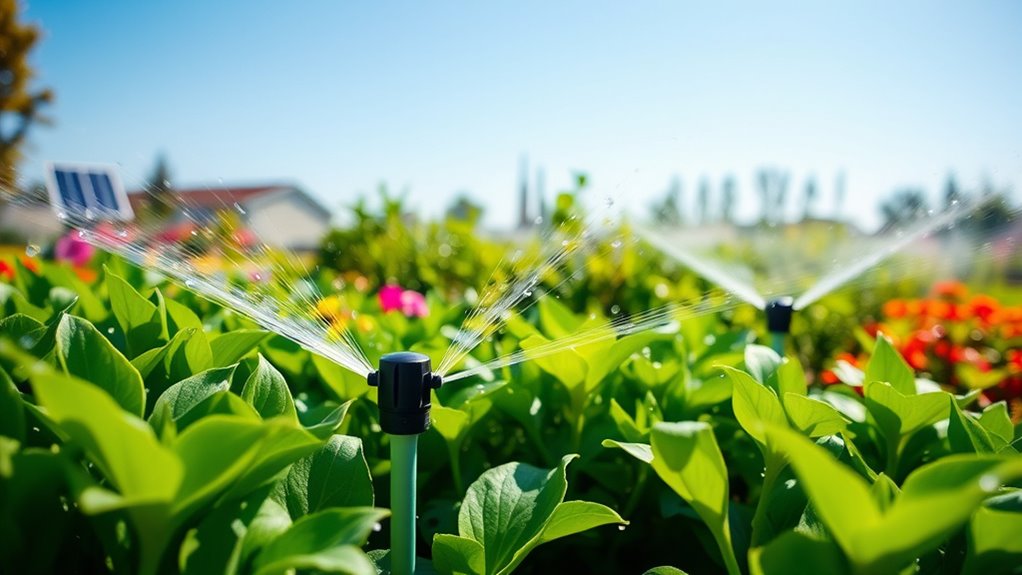
Smart irrigation systems can substantially cut your water bills by delivering just the right amount of water. They also minimize waste, helping conserve this essential resource. Plus, by using eco-friendly technology, you’re making a positive impact on the environment while saving money.
Lower Water Bills
Implementing smart irrigation systems can considerably lower your water bills by optimizing watering schedules based on real-time data. This targeted approach guarantees your garden receives the right amount of water, promoting lush garden aesthetics and healthy plants without excess. By avoiding overwatering, you save money and reduce water waste. Plus, healthier plants are more resilient, reducing the need for additional treatments or replacements. To maximize benefits, consider these ideas:
- Regularly adjust watering schedules based on weather forecasts
- Use moisture sensors to prevent unnecessary watering
- Prioritize efficient watering zones for high-value plants
With smarter watering, you enjoy vibrant gardens, healthier plants, and lowered costs, all while making a positive environmental impact.
Reduced Water Waste
By reducing unnecessary water use, smart irrigation systems considerably cut down on water waste, leading to both cost savings and environmental benefits. These systems monitor soil moisture levels precisely, watering only when your garden needs it. This targeted approach prevents overwatering, which can harm plant health and waste resources. By maintaining ideal soil moisture, your plants stay healthy and vigorous without excess water runoff or evaporation. As a result, you save money on water bills and lessen your environmental impact by conserving this essential resource. Smart irrigation ensures that water is used efficiently, reducing waste while promoting robust plant growth. This balance helps you achieve a lush garden while making a positive difference for the environment.
Eco-Friendly Benefits
Using smart irrigation systems can substantially lower your water bills by optimizing water usage, which directly translates into cost savings. By implementing eco-friendly practices, you contribute to water conservation and reduce your environmental footprint. These systems adjust watering schedules based on weather data, soil moisture, and plant needs, ensuring you don’t waste a drop. The benefits extend beyond savings; they promote sustainable gardening and protect natural resources.
- Minimize water waste through precise delivery
- Reduce energy consumption associated with overwatering
- Support eco-friendly practices that benefit local ecosystems
With smart irrigation, you’re not just saving money—you’re actively helping preserve water and promote environmental health for future generations.
Tips for Maintaining Your Smart Irrigation System
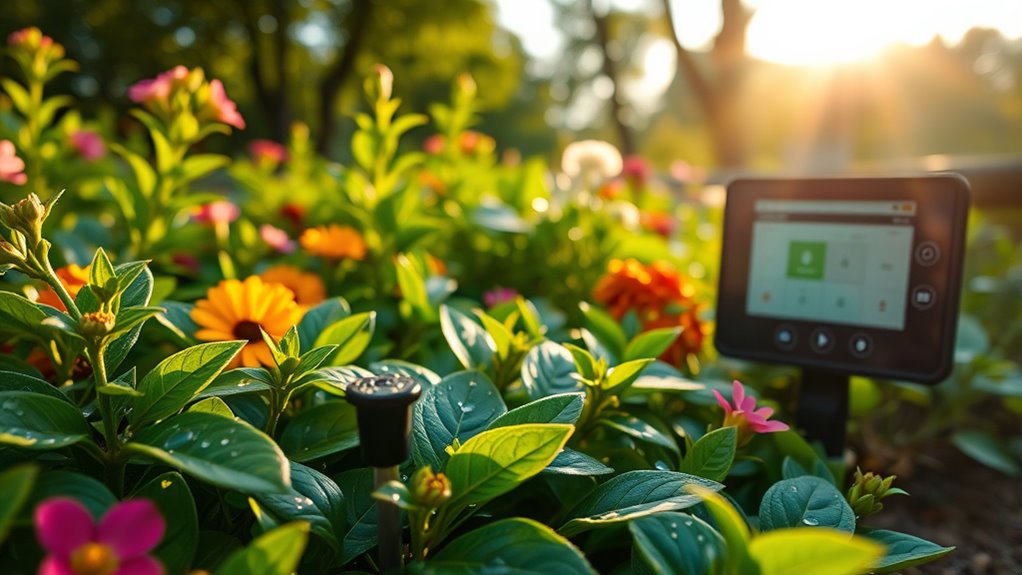
Regular maintenance is essential to keep your smart irrigation system functioning efficiently and prolong its lifespan. Start by inspecting the system regularly for leaks or clogs, which can affect water distribution and soil quality. Check the garden soil around your plants; uneven watering can harm plant health and disrupt soil nutrients. Clean or replace filters to guarantee water flows smoothly, preventing buildup that could damage components. Test your system’s sensors and controllers periodically to confirm accurate operation. Adjust watering schedules based on seasonal changes and weather patterns to avoid overwatering or underwatering. Keep sprinkler heads and emitters free of debris to maintain even coverage. Proper maintenance ensures your system supports healthy plants and optimizes water use, saving money and protecting your garden’s long-term vitality.
Future Trends in Garden Watering Technology
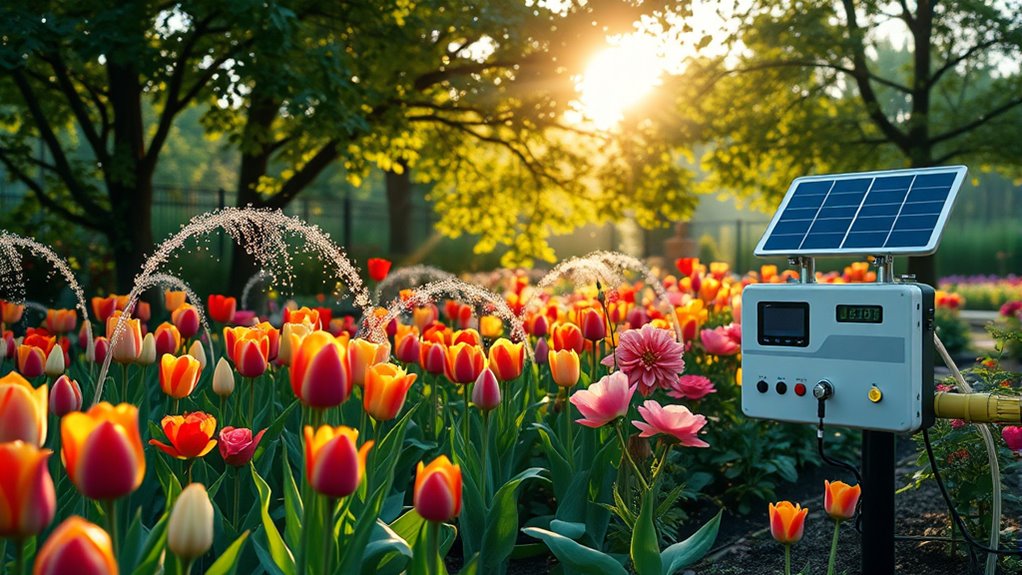
Advancements in garden watering technology are paving the way for smarter, more efficient systems that adapt seamlessly to environmental changes. Future trends include integrating drone surveillance to monitor plant health and soil moisture, allowing you to target watering precisely where needed. Additionally, garden design will increasingly incorporate automated systems that adjust watering patterns based on landscape layouts.
Smart watering systems with drone monitoring and AI integration will revolutionize garden care and efficiency.
Expect innovations such as:
- Real-time environmental data collection via drones
- AI-powered systems that learn your garden’s unique needs
- Smarter integration with garden design for personalized watering schedules
These developments will make garden management easier, reduce water waste, and optimize plant health. As technology advances, you’ll have more control and insight into your garden’s watering needs, creating a sustainable and lush outdoor space.
Frequently Asked Questions
How Secure Is My Data With a Smart Irrigation System?
You might wonder about your data privacy and cybersecurity risks with a smart irrigation system. These systems collect and transmit your garden data, so it’s natural to worry about security. Manufacturers often implement encryption and secure protocols to protect your information. However, vulnerabilities can still exist if updates aren’t maintained. Always choose reputable brands, update firmware regularly, and use strong passwords to keep your data safe and minimize cybersecurity risks.
Can Smart Irrigation Systems Be Integrated With Existing Smart Home Devices?
Imagine your smart home as a symphony, with each device playing in harmony. Yes, smart irrigation systems can blend seamlessly with your existing smart home devices through integration compatibility. They synchronize effortlessly, like dancers in perfect step, allowing you to control watering schedules via your voice or app. This device synchronization makes managing your garden as smooth as a melody, bringing convenience and efficiency to your smart home ecosystem.
Are There Any Recommended Brands for Budget-Friendly Options?
When looking for affordable options, you’ll find several budget-friendly brands that offer smart irrigation systems. Brands like Rachio, Orbit, and RainMachine provide reliable, budget-friendly options that fit various garden sizes and needs. These systems are easy to install and use, helping you save water and money. By choosing these brands, you get smart technology at a price that won’t break the bank, making your gardening more efficient and eco-friendly.
How Does Smart Irrigation Handle Water Restrictions or Drought Conditions?
Imagine your garden thriving despite a drought apocalypse—smart irrigation makes this possible. It uses advanced drought adaptations and water conservation strategies, adjusting watering schedules based on weather forecasts and soil moisture. You won’t squander a drop, even during water restrictions. This tech ensures your plants get just what they need, reducing waste and helping you stay compliant with restrictions, all while keeping your garden lush and healthy.
What Maintenance Is Required to Keep the System Functioning Effectively?
To keep your system functioning effectively, you should regularly perform system calibration to guarantee accurate watering schedules. Additionally, you need to clean filters frequently to prevent clogs and maintain water flow. Check for any leaks or damaged components, and update the software if necessary. Proper maintenance ensures your irrigation system runs smoothly, conserves water, and keeps your garden healthy with minimal effort.
Conclusion
Imagine your garden thriving, each plant basking in just the right amount of water, all thanks to your smart irrigation system. With its gentle, precise watering, you’ll see lush greenery bloom while conserving precious water. As you sit back and enjoy your vibrant garden, know that you’re making a difference—for your plants, your wallet, and the planet. Embrace this technology and watch your outdoor space flourish effortlessly, year after year.

